Biermann Ch. Handbook of Pulping and Papermaking
Подождите немного. Документ загружается.

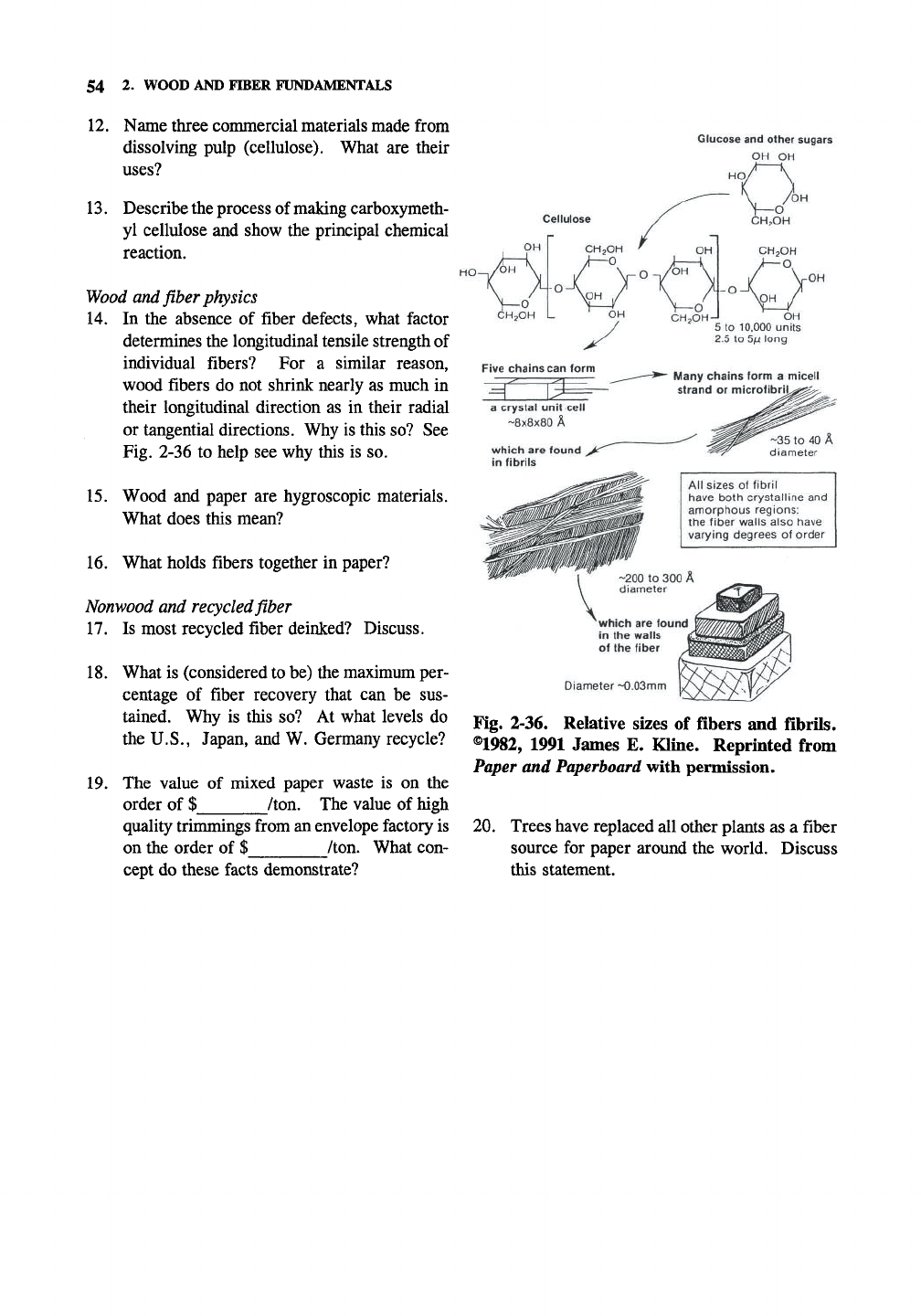
54 2. WOOD AND FIBER FUNDAMENTALS
12.
Name three commercial materials made from
dissolving pulp (cellulose). What are their
uses?
13.
Describe the process of making carboxymeth-
yl cellulose and show the principal chemical
reaction.
Wood and fiber physics
14.
In the absence of fiber defects, what factor
determines the longitudinal tensile strength of
individual fibers? For a similar reason,
wood fibers do not shrink nearly as much in
their longitudinal direction as in their radial
or tangential directions. Why is this so? See
Fig. 2-36 to help see why this is so.
15.
Wood and paper are hygroscopic materials.
What does this mean?
16.
What holds fibers together in paper?
Nonwood and recycled fiber
17.
Is most recycled fiber deinked? Discuss.
18.
What is (considered to be) the maximum per-
centage of fiber recovery that can be sus-
tained. Why is this so? At what levels do
the U.S., Japan, and W. Germany recycle?
19.
The value of mixed paper waste is on the
order of $ /ton. The value of high
quality trimmings from an envelope factory is
on the order of $ /ton. What con-
cept do these facts demonstrate?
Glucose and other sugars
OHOH
CHpOH
Diameter ~0.03mm
Fig. 2-36. Relative sizes of fibers and Hbrils.
®1982,
1991 James E. Kline. Reprinted from
Paper and Paperboard with permission.
20.
Trees have replaced all other plants as a fiber
source for paper around the world. Discuss
this statement.
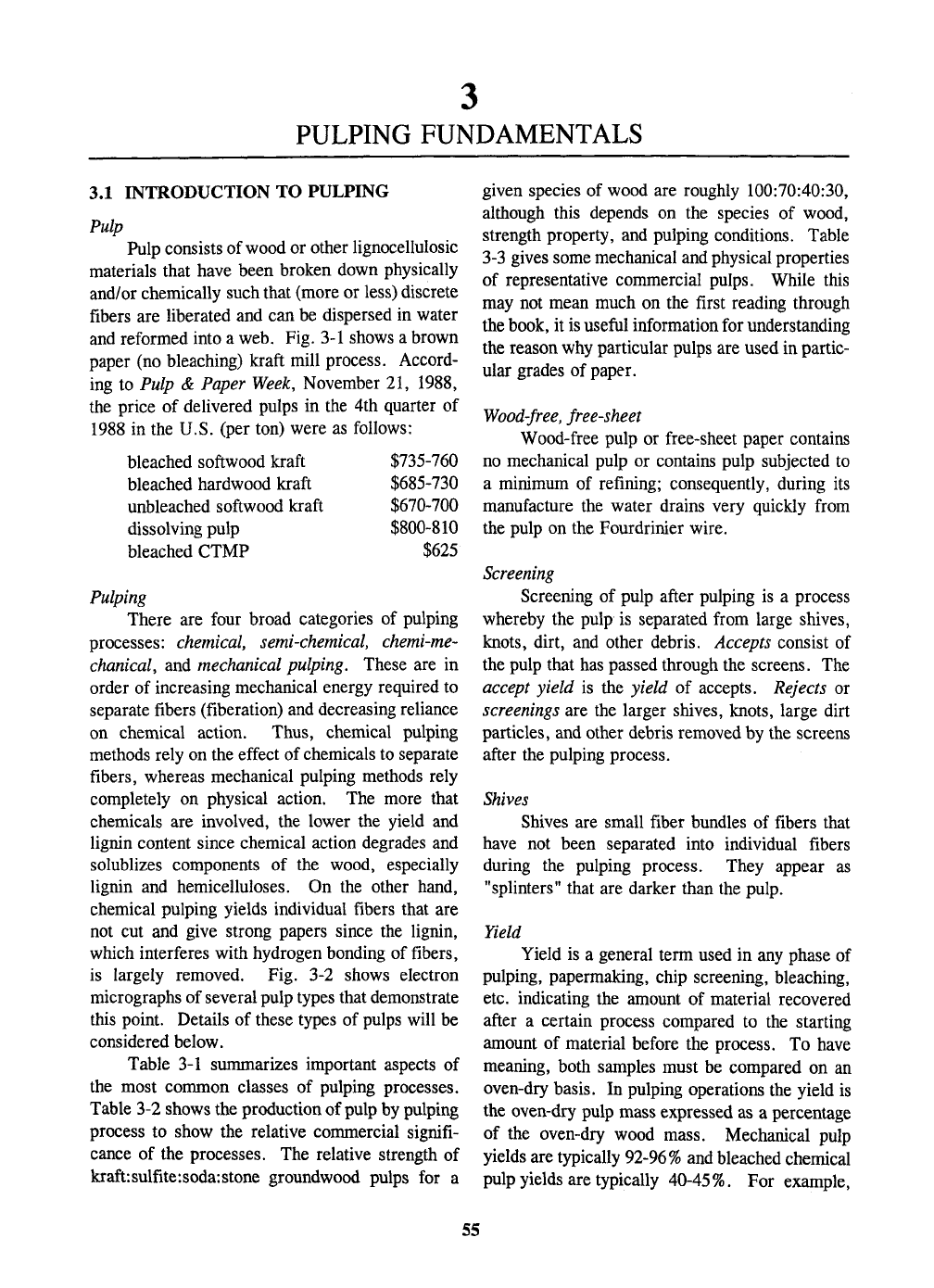
PULPING FUNDAMENTALS
3.1 INTRODUCTION TO PULPEVG
Pulp
Pulp consists of wood or other lignocellulosic
materials that have been broken down physically
and/or chemically such that (more or less) discrete
fibers are liberated and can be dispersed in water
and reformed into a web. Fig. 3-1 shows a brown
paper (no bleaching) kraft mill process. Accord-
ing to Pulp & Paper Week, November 21, 1988,
the price of delivered pulps in the 4th quarter of
1988 in the U.S. (per ton) were as follows:
bleached softwood kraft $735-760
bleached hardwood kraft $685-730
unbleached softwood kraft $670-700
dissolving pulp $800-810
bleached CTMP $625
Pulping
There are four broad categories of pulping
processes: chemicaly semi-chemical, chemi-me-
chanical, and mechanical pulping. These are in
order of increasing mechanical energy required to
separate fibers (fiberation) and decreasing reliance
on chemical action. Thus, chemical pulping
methods rely on the effect of chemicals to separate
fibers, whereas mechanical pulping methods rely
completely on physical action. The more that
chemicals are involved, the lower the yield and
lignin content since chemical action degrades and
solublizes components of the wood, especially
lignin and hemicelluloses. On the other hand,
chemical pulping yields individual fibers that are
not cut and give strong papers since the lignin,
which interferes with hydrogen bonding of fibers,
is largely removed. Fig. 3-2 shows electron
micrographs of several pulp types that demonstrate
this point. Details of these types of pulps will be
considered below.
Table 3-1 summarizes important aspects of
the most conmion classes of pulping processes.
Table 3-2 shows the production of
pulp
by pulping
process to show the relative commercial signifi-
cance of the processes. The relative strength of
kraft:sulfite:soda:stone groundwood pulps for a
given species of wood are roughly 100:70:40:30,
although this depends on the species of wood,
strength property, and pulping conditions. Table
3-3 gives some mechanical and physical properties
of representative commercial pulps. While this
may not mean much on the first reading through
the book, it is usefiil information for understanding
the reason why particular pulps are used in partic-
ular grades of paper.
Wood-free, free-sheet
Wood-free pulp or free-sheet paper contains
no mechanical pulp or contains pulp subjected to
a minimum of refining; consequently, during its
manufacture the water drains very quickly from
the pulp on the Fourdrinier wire.
Screening
Screening of pulp after pulping is a process
whereby the pulp is separated from large shives,
knots,
dirt, and other debris. Accepts consist of
the pulp that has passed through the screens. The
accept yield is the yield of accepts. Rejects or
screenings are the larger shives, knots, large dirt
particles, and other debris removed by the screens
after the pulping process.
Shives
Shives are small fiber bundles of fibers that
have not been separated into individual fibers
during the pulping process. They appear as
"splinters" that are darker than the pulp.
Yield
Yield is a general term used in any phase of
pulping, papermaking, chip screening, bleaching,
etc.
indicating the amount of material recovered
after a certain process compared to the starting
amount of material before the process. To have
meaning, both samples must be compared on an
oven-dry basis. In pulping operations the yield is
the oven-dry pulp mass expressed as a percentage
of the oven-dry wood mass. Mechanical pulp
yields are typically 92-96% and bleached chemical
pulp yields are typically 40-45%. For example.
55
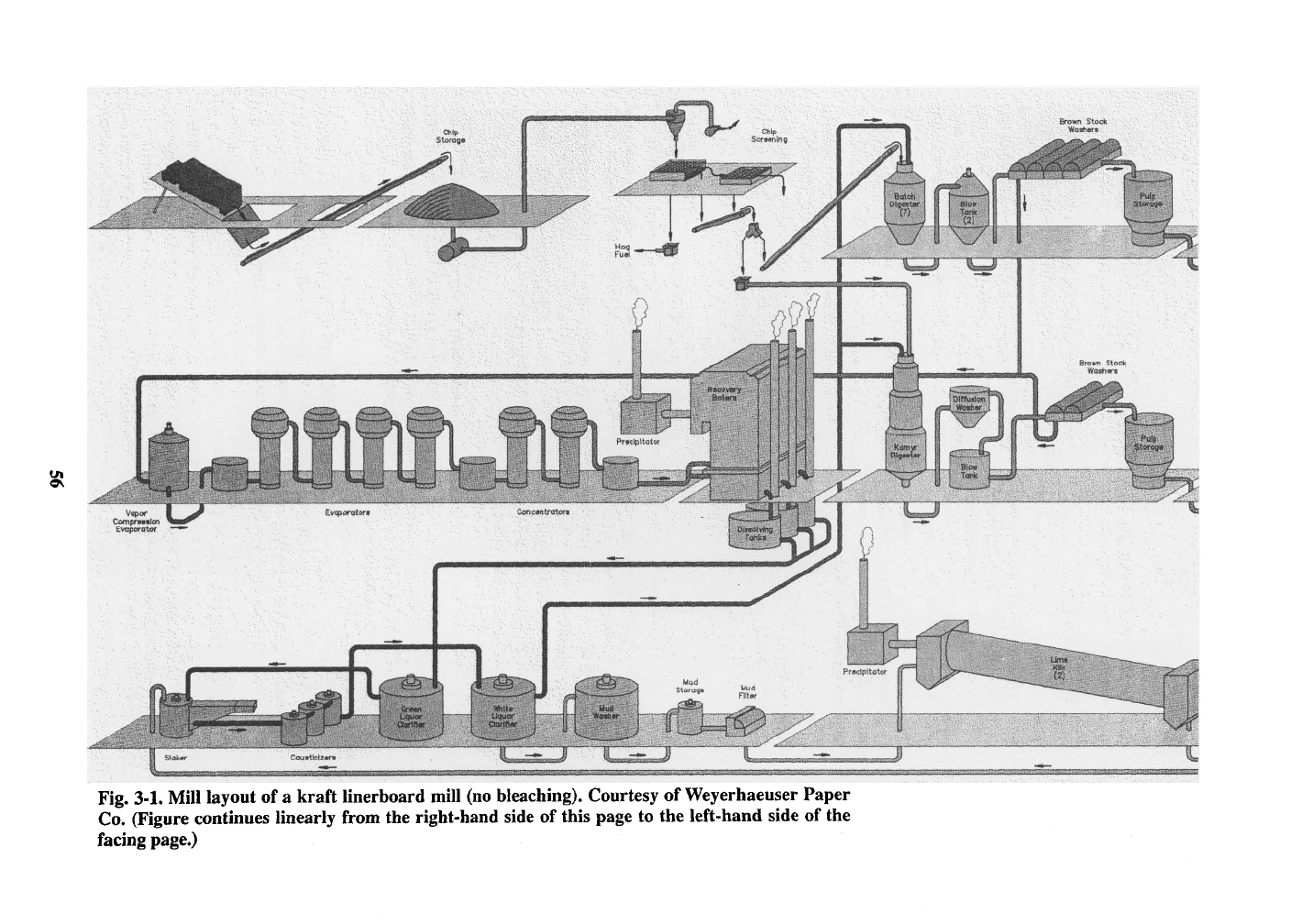
Qm
-M
C^
CM
Ck
O
2
c
§
2
U
^
«
I
.S.S
c«
.S
a
^
O.S
ro
fe
gp
.2f
6
g
56

IS
I
01)
57
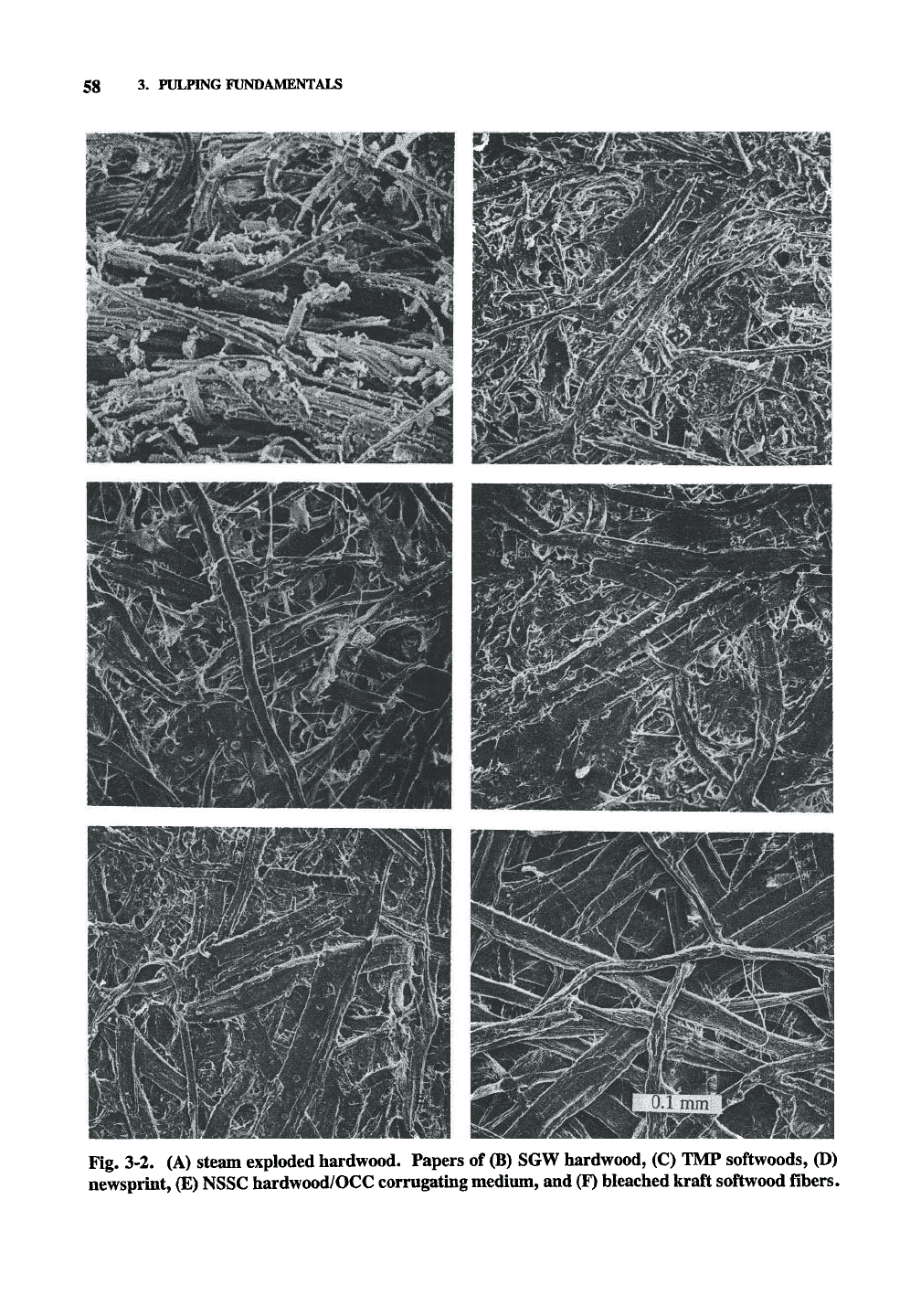
58 3. PULPING FUNDAMENTALS
Fig. 3-2. (A) steam exploded hardwood. Papers of (B) SGW hardwood, (C) TMP softwoods, (D)
newsprint, (E) NSSC hardwood/OCC corrugating medium, and (F) bleached kraft softwood fibers.

INTRODUCTION TO PULPING
59
Table 3-1. Summary of pulping processes/
Process
Mechanical
pulping
Chemi-
mechanical
pulping
Kraft pro-
cess,
pH 13-14
Sulfite, acid
or bisulfite
pH 1.5-5
Neutral
sulfite
semi-chemi-
cal (NSSC)
pH 7-10
Chemicals
none; grind-
stones for logs;
disk refiners for
chips
CTMP; mild
action; NaOH
or NaHSOa
NaOH + Na2S
(15-25%
on
wood);
unlined
! digester, high
recovery of
pulping chemi-
cals,
sulfur odor
H2SO3 + HSO3
with Ca^-',
Mg2-^,
Na-', or
NH4^
base;
Ca^"^
is tradi-
tional but out-
dated since no
recovery pro-
cess;
lined
digesters
Mg^"^
base
Na2S03 +
NajCOj
about 50% of
the chemical
recovered as
Na2S04
Species
Hardwoods
, like poplar or
light-colored
softwoods like
1 spruce, balsam
fir, hemlock,
true firs
All woods
hardwoods-
poplar and
birch and non-
resinous soft-
woods; Doug-
las-fir is un-
suitable
almost all
species-spruce
and true firs
preferred
Hardwoods
(preferred)
aspen, oak.
alder elm.
birch; soft-
woods Doug-
las-fir sawdust
and chips
Pulp Properties
High opacity.
softness,
bulk.
Low strength
and brightness.
Moderate
strength
High strength.
brown pulps
unless bleached
light brown
pulp if un-
bleached,
easily bleached
to high bright-
ness,
weaker
than kraft pulp.
but higher yield
Same as above
but lighter
color and
slightly stron-
ger
Good stiffness
and moldability
Uses
Newsprint,
books.
magazines.
Bag, wrap-
ping,
linerboard.
bleached
pulps for
white
papers
Fine pa-
per, tissue.
glassine.
strength
reinforce-
ment in
newsprint
Newsprint,
fine
pa-
pers,
etc.
Cor-
rugating
medium
i
Yield,
%
1
92-96%
88-95%
65-70%
ft)r
brown
papers, 47-
50%
for
bleachable
pulp;
43-
45%
after
bleaching
48-51%
for
bleachable
pulp;
46-
48%
after
bleaching
50-51%
for
bleachable
pulp
48-50%
after
bleaching
70-80%
^Reprinted from Krahmer, R.L. and A.C. VanVliet, Ed., WboJ Technology and Utilization,
O.S.U.
Bookstore, Corvallis, Ore., 1983 with permission.

60
3.
PULPING FUNDAMENTALS
Table 3-2. Approximate pulp production (thousands of MT) by pulping method/
Category
Mechanical
pulp
Chemical
Semi-
chemical
Chemi-
mechanical
Process
TMP
CTMP
SGW
1
PGW
RMP
Kraft
Total 1
Bleached
softwood
hardwood
Sulfite 1
Dis-
solv-
ing
Kraft
Sulfite
Soda (hardwoods)
NSSC,
etc.
steam explosion/
Asplimd
cold soda
1 Total virgin wood pulp
Wastepaper, recycling
U.S. 1990
3400
30
3200
600
342
50,000
14,000
13,000
1600
800
650
1
300
5000
600
1
200
1 62,700
1 18,400
U.S. 1960
3292
14,590
2578
1138
total
420
1991
total
25,316
8000
Canada 1989
7000
2800
10,850
6868
1577
1627
273
total
432
23,700
Global
1986
II
31,000
total
88,000 II
29,000
26,000 II
9000
II
8000
136,000
56.000 1
^Data from 1990 Pulp and Paper
Fact
Book as pulp productions or capacities, FAO, and Libby Volume
I for U.S. 1960 data. There is significant rounding of values here as this table is meant only as an
approximation. Different sources differ appreciably in amounts. In 1986 the world paper production
was 202,000 thousand tons. The nonwood and non-secondary fiber portion of 10,000 tons consists of
minerals for coating and fillers and other plant fibers such as bagasse, straw, and bamboo.
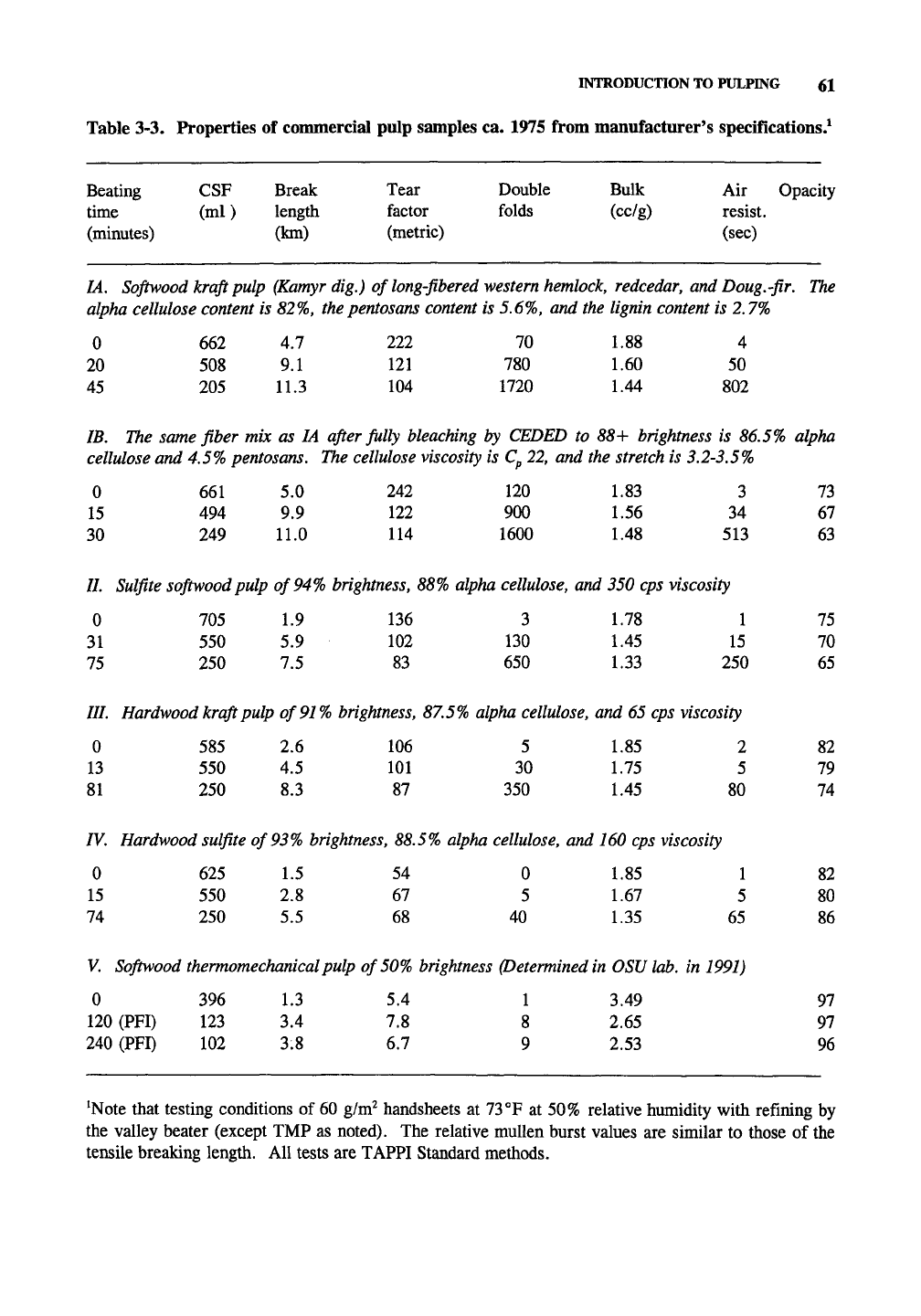
Beating
time
(minutes)
CSF
(ml)
Break
length
(km)
Tear
factor
(metric)
Double
folds
Bulk
(cc/g)
INTRODUCTION TO PULPING 61
Table 3-3. Properties of commercial pulp samples ca. 1975 from manufacturer's specifications.^
Air Opacity
resist.
(sec)
lA.
Softwood kraftpulp
(Kamyr
dig,) of
long-fibered
western hemlocK redcedar, and
Doug^-fir,
The
alpha cellulose content is 82%, the pentosans content is 5.6%, and the lignin content is 2.7%
0 662 4.7 222 70 1.88 4
20 508 9.1 121 780 1.60 50
45 205 11.3 104 1720 1.44 802
IB.
The same fiber mix as lA after fidlly bleaching by CEDED to 88-\- brightness is 86.5% alpha
cellulose and 4.5% pentosans. The cellulose viscosity is
Cp
22, and the stretch is
3.2-3.5%
0
15
30
661
494
249
5.0
9.9
11.0
242
122
114
120
900
1600
1.83
1.56
1.48
3
34
513
73
67
63
//. Sulfite
softwood
pulp of
94%
brightness, 88% alpha cellulose, and 350 cps viscosity
0
31
75
705
550
250
1.9
5.9
7.5
136
102
83
3
130
650
1.78
1.45
1.33
1
15
250
75
70
65
///. Hardwood kraft pulp of
91%
brightness, 87.5% alpha cellulose, and 65 cps viscosity
0
13
81
585
550
250
2.6
4.5
8.3
106
101
87
5
30
350
1.85
1.75
1.45
2
5
80
82
79
74
IV. Hardwood sulfite of
93%
brightness, 88.5% alpha cellulose, and 160 cps viscosity
0 625 1.5 54 0 1.85 1
15 550 2.8 67 5 1.67 5
74 250 5.5 68 40 1.35 65
V.
Softwood
thermomechanical pulp of
50%
brightness determined
in
OSV
lab.
in 1991)
0 396 1.3 5.4 1 3.49
120 (PFI) 123 3.4 7.8 8 2.65
240 (PFI) 102 3.8 6.7 9 2.53
82
80
86
97
97
96
^Note that testing conditions of 60 g/m^ handsheets at
73 °F
at 50% relative humidity with refining by
the valley beater (except TMP as noted). The relative mullen burst values are similar to those of the
tensile breaking length. All tests are TAPPI Standard methods.

62
3.
PULPING FUNDAMENTALS
100 lb of dry wood yields about 40 to 45 lb of
pulp for bleached printing paper.
yield,
%
=
dry product mass
out ^ ^^^^
dry material mass in
Total
yield,
%
The total yield is equal to the amount of pulp
removed during screening and the yield of pulp
after the screens when all three are expressed as a
percentage of the original wood put in the digest-
er. When one speaks of pulp yield it is necessary
to state whether it is the total yield or screened
yield.
Total yield (%) = Screenings (%) + Screened yield (%)
Consistency
Consistency is a measure of the solids
content
as a percentage in a pulp slurry.
dry solids mass ^
.
^^
consistency
=
— x 100%
slurry mass
3.2 MECHANICAL PULPING
Mechanical Pulp
Mechanical pulp is pulp produced by using
only mechanical attrition to pulp lignocellulosic
materials; no chemicals (other than water or
steam) are used. Light colored, non-resinous
softwoods and some hardwoods are often the fiber
source. The total yield is about 90-98%. Lignin
is retained in the pulp; therefore, high yields of
pulp are obtained from wood. Mechanical pulps
are characterized by high yield, high bulk, high
stiffness, and low cost. They have low strength
since the lignin interferes with hydrogen bonding
between fibers when paper is made. The lignin
also causes the pulp to turn yellow with exposure
to air and light.
The use of mechanical pulps is confined
mainly to non-permanent papers like newsprint and
catalog paper. Mechanical pulps constitute 20-
25%
of the world production and this is increasing
due to the high yield of the process and increasing
competition for fiber resources. Furthermore,
technological advances have made mechanical
pulps increasingly desirable.
Table 3-4. Mechanical pulp capacity by region
in thousands of metric tons^
Region
USA
Canada
Scandinavia
Europe
Japan
Other
Year
1980
1988
1980
1988
1980
1988
1980
1988
1980
1988
1980
1988
IMP
1619
3028
996
4144
1411
4596
663
1559
862
1161
320
1238
'Data from Kayserberg (1989).
exclude Scandinavia.
CTMP
0
38
110
2421
110
685
30
155
0
310
0
897
Europe
PGW
0
224
0
0
40
743
0
307
0
150
0
44
values
Table 3-4 shows the production of various
types of mechanical pulp in 1980 and 1988 for
several areas of the world. During this time
global mechanical pulp production increased from
6 to 15 million metric tons. Several important
aspects of mechanical pulping are condensed from
this article. In the last decade, TMP processes
have largely replaced SGW. CTMP and bleached
CTMP (BCTMP) are displacing small amounts of
chemical pulps in certain grades of paper. Most
CTMP is produced in Canada. PGW is important
in Scandinavia, but has limited production outside
this region.
Chip quality and cleanliness
Some aspects of chip quality are very impor-
tant in mechanical pulping. Since mechanical
pulps cannot be brightened very much by chemi-
cals,
chip quality (except for SGW, which uses
wood logs) is of extreme importance. Generally
chips less than two weeks old are used with
stringent bark and dirt tolerances. Chips older
than two weeks tend to be discolored too much by
decay and air oxidation. Washing the chips (Fig.
3-3 shows one type of chip washing system)
before pulping is a necessity, just as in any me-

MECHANICAL PULPING
63
r
Chip Sump
During operation, the chip sump maintains
uniform chip consistency in the mixture.
When the plant is shutdown, the chip sump
stores the Uquid volume contained in the
system.
recycled
cleaned water
Scrap Separator
The rotating paddles of the
agitator force the chips
under the water surface,
where heavy material
separates and sinks to the
scrap trap. A water current
from the bottom of the
scrap separator carries the
light chips up to the outlet.
The scrap trap is equipped with two butterfly valves
controlled by time-programmed pneumatic control
units for automatic discharge.
Chip Pump
The chip pump transports the chip/water mixture up
to the screw drainer.
The violent turbulence created in the chip-liquid
mixture by the pump provides additional cleaning by
separating small foreign particles from the chips.
Screw Drainer
The screw drainer consists of feed screw and screen
plate. The lower section, the washing zone, is filled
with water.
An overflow box is included to maintain a constant
water level and to allow sedimentation of impurities.
The chips are rinsed in the washing zone while being
transported upwards by the feed screw. Washed out
impurities are deposited in the sand trap.
The feed screw conveys the chips over the perforated
screen plate where excess water is drained off. The
narrow clearance between screen plate and feed screw
makes the screen plate self-cleaning.
The rinsing water is fed through the upper end of the
screw drainer and flushes remaining particles down to
the sand trap.
Fig. 3-3. Chip washing system that incorporates water reuse. Courtesy of Sunds Defibrator.
